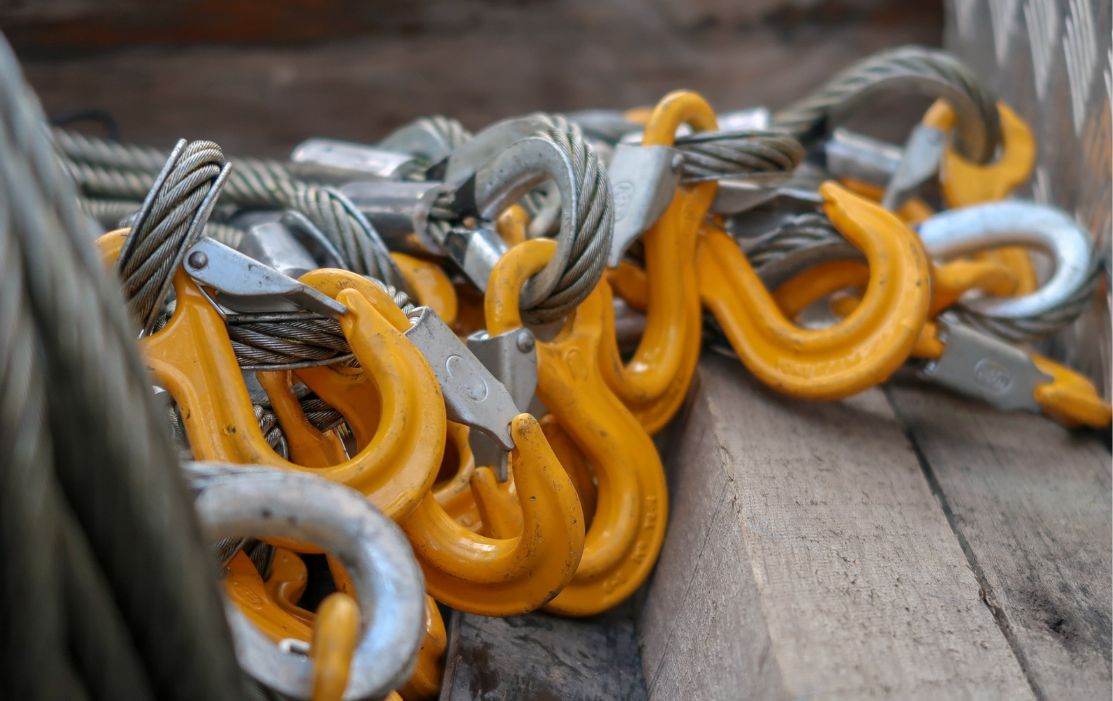By H-Lift | 16 October 2023 | 0 Comments
Safe Use of Wire Rope Sling
Selecting the Correct Sling
Using Wire Rope Slings Safely
Safe Use of Wire Rope Slings

- Wire rope slings are available in a range of sizes and assemblies, select the slings to be used and plan the lift taking the following into account:
- Type of sling to be used - endless, single, two, three or four leg. Capacity - the sling must be both long enough and strong enough for the load and the slinging method.
- Apply the mode factor for the slinging method.
- For use at temperatures exceeding 100°C or below minus 40°C refer to the suppliers instructions.
- Where slings may come into contact with acids or chemicals consult the supplier.
- In the case of multi-leg slings the angle between the legs should not be less than 30° or exceed the maximum marked. Multi-leg slings exert a gripping force on the load which must be taken into account, this increases as the angle between the legs increases.
- Due to the possibility of sparking, the use of aluminium is restricted in certain classified atmospheres, so ensure the ferrule is suitable for such conditions.
Using Wire Rope Slings Safely
- Do not attempt lifting operations unless you understand the use of the equipment, the slinging procedures and the mode factors to be applied.
- Do not use defective slings or accessories.
- Do not force, hammer or wedge slings or fittings into position. They must fit freely. Check to ensure correct engagement of fittings and appliances.
- Position hooks of multi-leg slings facing outward from the load. Do not lift on the point of a hook.
- Ensure that the wire rope is not twisted or knotted.
- Ensure the effective diameter of pins, hooks etc upon which soft eyes fit is at least 2 x the wire rope diameter.
- Position the splices of endless slings in the standing part of the sling away from hooks and fittings.
- Never join wire rope slings made from different lays of rope together as this will cause them to un-lay thus seriously affecting their capacity.
- Back hook free legs to the masterlink to avoid lashing legs which might accidentally become engaged or otherwise become a hazard.
- Take the load steadily and avoid shock loads.
- Do not leave suspended loads unattended. In an emergency cordon off the area.
Safe Use of Wire Rope Slings
- Good slinging practice must ensure that the load is as safe and secure in the air as it was on the ground and that no harm is done to the load, lifting equipment, other property or persons.
- Establish the weight of the load, ensure the lifting method is suitable and inspect the sling and attachments for obvious defects. Prepare the landing area making sure the floor is strong enough to take the load. Follow any specific instructions from the supplier.
- Ensure the lifting point is over the centre of gravity. Any loose parts of the load should be removed or secured. Secure the sling firmly to the load by hooks onto lifting points or shackles etc. The sling must not be twisted, knotted or kinked in any way.
- Use packing to prevent damage to the sling from corners or edges and to protect the load.
- Do not exceed the SWL or rated angle. Any choke angle must not exceed 120° and any basket 90°.
- Do not hammer, force or wedge slings or accessories into position; they must fit freely.
- When attaching more than one sling to the hook of the appliance use a shackle to join the slings and avoid overcrowding the hook.
- Use an established code of signals to instruct the crane driver.
- Ensure the load is free to be lifted and not, for example, bolted down.
- Check that there are no overhead obstacles such as power lines.
- Keep fingers, toes etc clear ensuring they do not become trapped when lifting, lowering or controlling loads.
- Make a trial lift by raising the load a little to ensure it is balanced, stable and secure and if not lower it and adjust the slinging arrangement.
- Where appropriate use tag lines to control the load.
- Except where special provision is made, do not allow anyone to pass under or ride upon the load. The area should be kept clear.
- Make a trial set down, ensure the sling will not become trapped and the load will not tip when the slings are released.
- Use supports which are strong enough to sustain the load without crushing.
- Never drag slings over floors etc or attempt to drag a trapped sling from under a load.
- Never use a sling to drag a load.
- Place the hooks of free legs back onto the master link and take care to ensure that empty hooks do not become accidentally engaged.
- Never use slings in contact with chemicals or heat without the manufacturers approval.
- Never use damaged or contaminated slings.
- On completion of the lift return all equipment to proper storage.

Leave a Reply
Your email address will not be published.Required fields are marked. *
TAGS